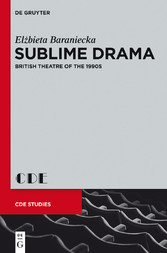Search and Find
Service
Acknowledgements
7
1 Introduction
11
1.1 Thesis
11
1.2 Overview of Chapters
22
1.3 Previous Research
28
2 Theory of the Sublime
39
2.1 Longinus
42
2.1.1 “The echo of a great soul”
43
2.1.2 Sappho and the Threatened Subject
44
2.1.3 The Turn of the Sublime
46
2.2 Edmund Burke
48
2.2.1 Towards an Aesthetic of Shocks: Burke
48
2.2.2 The Beautiful and the Sublime
51
2.3 Immanuel Kant
54
2.3.1 Characteristics of the Aesthetic Feeling
56
2.3.2 The Beautiful and the Sublime
57
2.4 Jean-François Lyotard
63
2.4.1 Lyotard and Kantian Reflective Aesthetic Judgement
63
2.4.2 Adjusting Kantian Sublime to the Postmodern Context
64
2.4.3 Realism
66
2.4.4 The Inhuman
71
2.4.5 The Threat of Privation
74
2.4.6 The Ungraspable Presence
76
2.5 Summary
77
2.6 Theorizing the Sublime for Drama Analysis
81
3 Case Studies
87
3.1 Patrick Marber’s Closer
87
3.1.1 The Beautiful, the Agreeable and the Sublime
88
3.1.2 Synopsis
91
3.1.3 Internal Analysis: Moments of (In)Hospitality
92
3.1.4 External Analysis: Moments of the (Un)Familiar
116
3.2 Anthony Neilson’s Normal
126
3.2.1 Synopsis
126
3.2.2 Bataille, Eros and Thanatos, and the Evil Inside
128
3.2.3 Internal Analysis: Wehner’s Sublime Encounter with Eros and Thanatos
132
3.2.4 The External Level: Ecstasy of Minds
155
3.3 Mark Ravenhill’s Faust Is Dead
163
3.3.1 Synopsis
164
3.3.2 Seduction in Realism and in Sublime
166
3.3.3 Internal Analysis: Consumerist Seduction of the Characters
170
3.3.4 External Analysis: Sublime Seduction of the Audience
205
3.4 Sarah Kane’s 4.48 Psychosis
215
3.4.1 The Impossible Synopsis
217
3.4.2 Internal Analysis: Singing on the Boundary
223
3.4.3 External Analysis: the Influence of the Parergonal Language on the Audience
256
4 Conclusion
261
5 Works Cited
271
All prices incl. VAT











